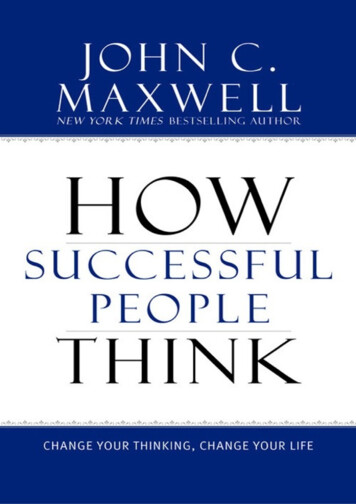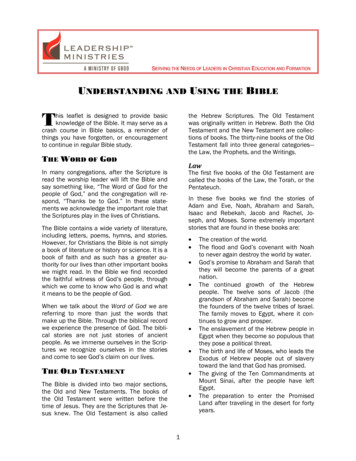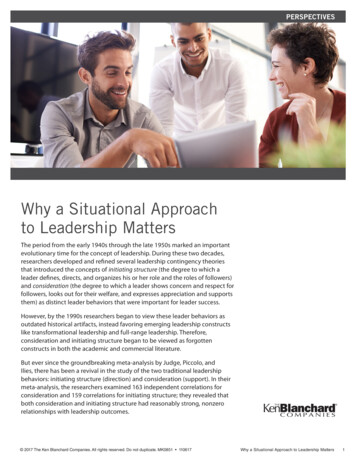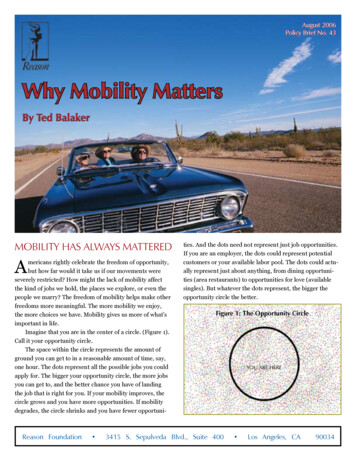
Transcription
Also by John C. Maxwell:RUNNING WITH GIANTSTODAY MATTERSTHINKING FOR A CHANGEETHICS 101MAKE TODAY COUNT
COPYRIGHTCopyright 2009 by John C. MaxwellAll rights reserved. Except as permitted under the U.S. Copyright Act of 1976, no part of this publication maybe reproduced, distributed, or transmitted in any form or by any means, or stored in a database or retrievalsystem, without the prior written permission of the publisher.Scriptures noted NIV are taken from the HOLY BIBLE: NEW INTERNATIONAL VERSION . Copyright 1973,1978, 1984, by International Bible Society. Used by permission of Zondervan Publishing House. All rightsreserved.Scriptures noted NRSV are taken from the NEW REVISED STANDARD VERSION of the Bible. Copyright 1989 by the Division of Christian Education of the National Council of The Churches of Christ in the U.S.A. Allrights reserved.The author is represented by Yates & Yates, LLP, Literary Agency, Orange, California.Center StreetHachette Book Group237 Park AvenueNew York, NY 10017Visit our website at www.HachetteBookGroup.com.Center Street is a division of Hachette Book Group, Inc.The Center Street name and logo are trademarks of Hachette Book Group, Inc.First eBook Edition: June 2009ISBN: 978-1-599-95215-4
ACKNOWLEDGMENTSI’d like to say thank you toMargaret Maxwell,who shares her thinking with me dailyCharlie Wetzel,who does my writingStephanie Wetzel,who proofs and edits the manuscript, andLinda Eggers,who runs my life
CONTENTSC OPYRIGHTACKNOWLEDGMENTSINTRODUCTION1: C ULTIVATE BIG-PICTURE THINKING2: ENGAGE IN FOCUSED THINKING3: HARNESS C REATIVE THINKING4: EMPLOY REALISTIC THINKING5: UTILIZE STRATEGIC THINKING6: EXPLORE POSSIBILITY THINKING7: LEARN FROM REFLECTIVE THINKING8: QUESTION POPULAR THINKING9: BENEFIT FROM SHARED THINKING10: PRACTICE UNSELFISH THINKING11: RELY ON BOTTOM-LINE THINKINGONE FINAL THOUGHTNOTESABOUT THE A UTHOR
INTRODUCTIONGood thinkers are always in demand. A person who knows how may always have a job, but the person whoknows why will always be his boss. Good thinkers solve problems, they never lack ideas that can build anorganization, and they always have hope for a better future. Good thinkers rarely find themselves at the mercyof ruthless people who would take advantage of them or try to deceive them, people like Nazi dictator AdolfHitler, who once boasted, “What luck for rulers that men do not think.” Those who develop the process of goodthinking can rule themselves—even while under an oppressive ruler or in other difficult circumstances. In short,good thinkers are successful.I’ve studied successful people for forty years, and though the diversity you find among them is astounding,I’ve found that they are all alike in one way: how they think! That is the one thing that separates successfulpeople from unsuccessful ones. And here’s the good news. How successful people think can be learned. If youchange your thinking, you can change your life!WHY YOU SHOULD CHANGE YOUR THINKINGIt’s hard to overstate the value of changing your thinking. Good thinking can do many things for you:generate revenue, solve problems, and create opportunities. It can take you to a whole new level—personallyand professionally. It really can change your life.Consider some things you need to know about changing your thinking:1. Changed Thinking Is Not AutomaticSadly, a change in thinking doesn’t happen on its own. Good ideas rarely go out and find someone. If youwant to find a good idea, you must search for it. If you want to become a better thinker, you need to work at it—and once you begin to become a better thinker, the good ideas keep coming. In fact, the amount of goodthinking you can do at any time depends primarily on the amount of good thinking you are already doing.2. Changed Thinking Is DifficultWhen you hear someone say, “Now this is just off the top of my head,” expect dandruff. The only people whobelieve thinking is easy are those who don’t habitually engage in it. Nobel Prize-winning physicist AlbertEinstein, one of the best thinkers who ever lived, asserted, “Thinking is hard work; that’s why so few do it.”Because thinking is so difficult, you want to use anything you can to help you improve the process.3. Changed Thinking Is Worth the InvestmentAuthor Napoleon Hill observed, “More gold has been mined from the thoughts of man than has ever beentaken from the earth.” When you take the time to learn how to change your thinking and become a better thinker,you are investing in yourself. Gold mines tap out. Stock markets crash. Real estate investments can go sour.But a human mind with the ability to think well is like a diamond mine that never runs out. It’s priceless.HOW TO BECOME A BETTER THINKERDo you want to master the process of good thinking? Do you want to be a better thinker tomorrow than youare today? Then you need to engage in an ongoing process that improves your thinking. I recommend you dothe following:1. Expose Yourself to Good Input
Good thinkers always prime the pump of ideas. They always look for things to get the thinking processstarted, because what you put in always impacts what comes out.Read books, review trade magazines, listen to tapes, and spend time with good thinkers. And whensomething intrigues you—whether it’s someone else’s idea or the seed of an idea that you’ve come up withyourself—keep it in front of you. Put it in writing and keep it somewhere in your favorite thinking place tostimulate your thinking.2. Expose Yourself to Good ThinkersSpend time with the right people. As I worked on this section and bounced my ideas off of some key people(so that my thoughts would be stretched), I realized something about myself. All of the people in my life whom Iconsider to be close friends or colleagues are thinkers. Now, I love all people. I try to be kind to everyone I meet,and I desire to add value to as many people as I can through conferences, books, audio lessons, etc. But thepeople I seek out and choose to spend time with all challenge me with their thinking and their actions. They areconstantly trying to grow and learn. That’s true of my wife, Margaret, my close friends, and the executives whorun my companies. Every one of them is a good thinker!The writer of Proverbs observed that sharp people sharpen one another, just as iron sharpens iron. If youwant to be a sharp thinker, be around sharp people.3. Choose to Think Good ThoughtsTo become a good thinker, you must become intentional about the thinking process. Regularly put yourselfin the right place to think, shape, stretch, and land your thoughts. Make it a priority. Remember, thinking is adiscipline.Recently I had breakfast with Dan Cathy, the president of Chick-fil-A, a fast food chain headquartered in theAtlanta area. I told him that I was working on this book and I asked him if he made thinking time a high priority.Not only did he say yes, but he told me about what he calls his “thinking schedule.” It helps him to fight the hecticpace of life that discourages intentional thinking. Dan says he sets aside time just to think for half a day everytwo weeks, for one whole day every month, and for two or three full days every year. Dan explains, “This helpsme ‘keep the main thing, the main thing,’ since I am so easily distracted.”You may want to do something similar, or you can develop a schedule and method of your own. No matterwhat you choose to do, go to your thinking place, take paper and pen, and make sure you capture your ideas inwriting.4. Act on Your Good ThoughtsIdeas have a short shelf life. You must act on them before the expiration date. World War I flying ace EddieRickenbacker said it all when he remarked, “I can give you a six-word formula for success: Think things through—then follow through.”5. Allow Your Emotions to Create Another Good ThoughtTo start the thinking process, you cannot rely on your feelings. In Failing Forward, I wrote that you can actyour way into feeling long before you can feel your way into action. If you wait until you feel like doing something,you will likely never accomplish it. The same is true for thinking. You cannot wait until you feel like thinking to doit. However, I’ve found that once you engage in the process of good thinking, you can use your emotions to feedthe process and create mental momentum.Try it for yourself. After you go through the disciplined process of thinking and enjoy some success, allowyourself to savor the moment and try riding the mental energy of that success. If you’re like me, it’s likely to spuradditional thoughts and productive ideas.6. Repeat the Process
One good thought does not make a good life. The people who have one good thought and try to ride it foran entire career often end up unhappy or destitute. They are the one-hit wonders, the one-book authors, theone-message speakers, the one-time inventors who spend their life struggling to protect or promote their singleidea. Success comes to those who have an entire mountain of gold that they continually mine, not those whofind one nugget and try to live on it for fifty years. To become someone who can mine a lot of gold, you need tokeep repeating the process of good thinking.PUTTING YOURSELF IN THE RIGHTPLACE TO THINKBecoming a good thinker isn’t overly complicated. It’s a discipline. If you do the six things I have outlined,you will set yourself up for a lifestyle of better thinking. But what do you do to come up with specific ideas on aday-to-day basis?I want to teach you the process that I’ve used to discover and develop good thoughts. It’s certainly not theonly one that works, but it has worked well for me.1. Find a Place to Think Your ThoughtsIf you go to your designated place to think expecting to generate good thoughts, then eventually you willcome up with some. Where is the best place to think? Everybody’s different. Some people think best in theshower. Others, like my friend Dick Biggs, like to go to a park. For me, the best places to think are in my car, onplanes, and in the spa. Ideas come to me in other places as well, such as when I’m in bed. (I keep a speciallighted writing pad on my nightstand for such times.) I believe I often get thoughts because I make it a habit tofrequently go to my thinking places. If you want to consistently generate ideas, you need to do the same thing.Find a place where you can think, and plan to capture your thoughts on paper so that you don’t lose them. WhenI found a place to think my thoughts, my thoughts found a place in me.2. Find a Place to Shape Your ThoughtsRarely do ideas come fully formed and completely worked out. Most of the time, they need to be shapeduntil they have substance. As my friend Dan Reiland says, they have to “stand the test of clarity andquestioning.” During the shaping time, you want to hold an idea up to strong scrutiny. Many times a thought thatseemed outstanding late at night looks pretty silly in the light of day. Ask questions about your ideas. Fine tunethem. One of the best ways to do that is to put your thoughts in writing. Professor, college president, and U.S.senator S. I. Hayakawa wrote, “Learning to write is learning to think. You don’t know anything clearly unless youcan state it in writing.”As you shape your thoughts, you find out whether an idea has potential. You learn what you have. You alsolearn some things about yourself. The shaping time thrills me because it embodies:Humor: The thoughts that don’t work often provide comic relief.Humility: The moments when I connect with God awe me.Excitement: I love to play out an idea mentally. (I call it “futuring” it.)Creativity: In these moments I am unhampered by reality.Fulfillment: God made me for this process; it uses my greatest gifts and gives me joy.Honesty: As I turn over an idea in my mind, I discover my true motives.Passion: When you shape a thought, you find out what you believe and what really counts.Change: Most of the changes I have made in my life resulted from thorough thinking on a subject.You can shape your thoughts almost anywhere. Just find a place that works for you, where you will be able towrite things down, focus your attention without interruptions, and ask questions about your ideas.3. Find a Place to Stretch Your Thoughts
If you come upon great thoughts and spend time mentally shaping them, don’t think you’re done and canstop there. If you do, you will miss some of the most valuable aspects of the thinking process. You miss bringingothers in and expanding ideas to their greatest potential.Earlier in my life, I have to admit, I was often guilty of this error. I wanted to take an idea from seed thoughtto solution before sharing it with anyone, even the people it would most impact. I did this both at work and athome. But over the years, I have learned that you can go much farther with a team than you can go alone.I’ve found a kind of formula that can help you stretch your thoughts. It says,The Right Thought plus the Right Peoplein the Right Environment at the Right Timefor the Right Reason the Right ResultThis combination is hard to beat. Like every person, every thought has the potential to become somethinggreat. When you find a place to stretch your thoughts, you find that potential.4. Find a Place to Land Your ThoughtsAuthor C. D. Jackson observes that “great ideas need landing gear as well as wings.” Any idea thatremains only an idea doesn’t make a great impact. The real power of an idea comes when it goes fromabstraction to application. Think about Einstein’s theory of relativity. When he published his theories in 1905and 1916, they were merely profound ideas. Their real power came with the development of the nuclear reactorin 1942 and the nuclear bomb in 1945. When scientists developed and implemented Einstein’s ideas, thewhole world changed.Likewise, if you want your thoughts to make an impact, you need to land them with others so that they cansomeday be implemented. As you plan for the application phase of the thinking process, land your ideas firstwith Yourself: Landing an idea with yourself will give you integrity. People will buy into an idea only after theybuy into the leader who communicates it. Before teaching any lesson, I ask myself three questions: “Do Ibelieve it? Do I live it? Do I believe others should live it?” If I can’t answer yes to all three questions, then Ihaven’t landed it.Key Players: Let’s face it, no idea will fly if the influencers don’t embrace it. After all, they are the peoplewho carry thoughts from idea to implementation.Those Most Affected: Landing thoughts with the people on the firing line will give you great insight.Those closest to changes that occur as a result of a new idea can give you a “reality read.” And that’simportant, because sometimes even when you’ve diligently completed the process of creating a thought,shaping it, and stretching it with other good thinkers, you can still miss the mark.5. Find a Place to Fly Your ThoughtsFrench philosopher Henri-Louis Bergson, who won the Nobel Prize in literature in 1927, asserted that aperson should “think like a man of action—act like a man of thought.” What good is thinking if it has noapplication in real life? Thinking divorced from actions cannot be productive. Learning how to master theprocess of thinking well leads you to productive thinking. If you can develop the discipline of good thinking andturn it into a lifetime habit, then you will be successful and productive all of your life. Once you’ve created,shaped, stretched, and landed your thoughts, then flying them can be fun and easy.PORTRAIT OF A GOOD THINKERYou often hear someone say that a colleague or friend is a “good thinker,” but that phrase means somethingdifferent to everyone. To one person it may mean having a high IQ, while to another it could mean knowing abunch of trivia or being able to figure out whodunit when reading a mystery novel. I believe that good thinking
isn’t just one thing. It consists of several specific thinking skills. Becoming a good thinker means developingthose skills to the best of your ability.It doesn’t matter whether you were born rich or poor. It doesn’t matter if you have a third grade education orpossess a Ph.D. It doesn’t matter if you suffer from multiple disabilities or you’re the picture of health. No matterwhat your circumstances, you can learn to be a good thinker. All you must do is be willing to engage in theprocess every day.In Built to Last, Jim Collins and Jerry Porras describe what it means to be a visionary company, the kind ofcompany that epitomizes the pinnacle of American business. They describe those companies this way: 1A visionary company is like a great work of art. Think of Michelangelo’s scenes from Genesis on theceiling of the Sistine Chapel or his statue of David. Think of a great and enduring novel likeHuckleberry Finn or Crime and Punishment. Think of Beethoven’s Ninth Symphony or Shakespeare’sHenry V . Think of a beautifully designed building, like the masterpieces of Frank Lloyd Wright orLudwig Mies van der Rohe. You can’t point to any one single item that makes the whole thing work; it’sthe entire work—all the pieces working together to create an overall effect—that leads to enduringgreatness.Good thinking is similar. You need all the thinking “pieces” to become the kind of person who can achievegreat things. Those pieces include the following eleven skills:Seeing the Wisdom of Big-Picture ThinkingUnleashing the Potential of Focused ThinkingDiscovering the Joy of Creative ThinkingRecognizing the Importance of Realistic ThinkingReleasing the Power of Strategic ThinkingFeeling the Energy of Possibility ThinkingEmbracing the Lessons of Reflective ThinkingQuestioning the Acceptance of Popular ThinkingEncouraging the Participation of Shared ThinkingExperiencing the Satisfaction of Unselfish ThinkingEnjoying the Return of Bottom-Line ThinkingAs you read the chapters dedicated to each kind of thinking, you will discover that they do not try to tell youwhat to think; they attempt to teach you how to think. As you become acquainted with each skill, you will find thatsome you do well, others you don’t. Learn to develop each of those kinds of thinking, and you will become abetter thinker. Master all that you can—including the process of shared thinking which helps you compensatefor your weak areas—and your life will change.
1Cultivate Big-Picture Thinking“Where success is concerned, people are not measured in inches, or pounds, or college degrees, orfamily background; they are measured by the size of their thinking.”—D AVID SCHWARTZBig-picture thinking can benefit any person in any profession. When somebody like Jack Welch tells a GEemployee that the ongoing relationship with the customer is more important than the sale of an individualproduct, he’s reminding them of the big picture. When two parents are fed up with potty training, poor grades,or fender-benders, and one reminds the other that the current difficult time is only a temporary season, then theybenefit from thinking big picture. Real estate developer Donald Trump quipped, “You have to think anyway, sowhy not think big?” Big-picture thinking brings wholeness and maturity to a person’s thinking. It bringsperspective. It’s like making the frame of a picture bigger, in the process expanding not only what you can see,but what you are able to do.Spend time with big-picture thinkers, and you will find that they:Learn ContinuallyBig-picture thinkers are never satisfied with what they already know. They are always visiting new places,reading new books, meeting new people, learning new skills. And because of that practice, they often are ableto connect the unconnected. They are lifelong learners.To help me maintain a learner’s attitude, I spend a few moments every morning thinking about my learningopportunities for the day. As I review my calendar and to-do list—knowing whom I will meet that day, what I willread, which meetings I will attend—I note where I am most likely to learn something. Then I mentally cue myselfto look attentively for something that will improve me in that situation. If you desire to keep learning, I want toencourage you to examine your day and look for opportunities to learn.Listen IntentionallyAn excellent way to broaden your experience is to listen to someone who has expertise in an area whereyou don’t. I search for such opportunities. One year I spoke to about 900 coaches and scouts at the SeniorBowl, where graduating football players participate in their last college game. I had the opportunity, along withmy son-in-law, Steve Miller, to have dinner with NFL head coaches Dave Wannstedt and Butch Davis. It’s notoften that you get such an opportunity, so I asked them questions about teamwork and spent a lot of timelistening to them. At the end of the evening, as Steve and I were walking to our car, he said to me, “John, I betyou asked those coaches a hundred questions tonight.”“If I’m going to learn and grow,” I replied, “I must know what questions to ask and know how to apply theanswers to my life. Listening has taught me a lot more than talking.”When you meet with people, it’s good to have an agenda so that you can learn. It’s a great way to partnerwith people who can do things you can’t. Big-picture thinkers recognize that they don’t know lots of things. Theyfrequently ask penetrating questions to enlarge their understanding and thinking. If you want to become a betterbig-picture thinker, then become a good listener.Look ExpansivelyWriter Henry David Thoreau wrote, “Many an object is not seen, though it falls within the range of our visualray, because it does not come within the range of our intellectual ray.” Human beings habitually see their ownworld first. For example, when people arrive at a leadership conference put on by my company, they want to
know where they’re going to park, whether they will be able to get a good (and comfortable) seat, whether thespeaker will be “on,” and if the breaks will be spaced right. When I arrive to speak at the same conference, Iwant to know that the lighting is good, the sound equipment is operating effectively, whether the speaker’splatform will be close enough to the people, etc. Who you are determines what you see—and how you think.Big-picture thinkers realize there is a world out there besides their own, and they make an effort to getoutside of themselves and see other people’s worlds through their eyes. It’s hard to see the picture while insidethe frame. To see how others see, you must first find out how they think. Becoming a good listener certainlyhelps with that. So does getting over your personal agenda and trying to take the other person’s perspective.Live CompletelyFrench essayist Michel Eyquem de Montaigne wrote, “The value of life lies not in the length of days, but inthe use we make of them; a man may live long yet live very little.” The truth is that you can spend your life anyway you want, but you can spend it only once. Becoming a big-picture thinker can help you to live withwholeness, to live a very fulfilling life. People who see the big picture expand their experience because theyexpand their world. As a result, they accomplish more than narrow-minded people. And they experience fewerunwanted surprises, too, because they are more likely to see the many components involved in any givensituation: issues, people, relationships, timing, and values. They are also, therefore, usually more tolerant ofother people and their thinking.WHY YOU SHOULD RECEIVE THE WISDOM OF BIG-PICTURE THINKINGIntuitively, you probably recognize big-picture thinking as beneficial. Few people want to be closed-minded.No one sets out to be that way. But just in case you’re not completely convinced, consider several specificreasons why you should make the effort to become a better big-picture thinker:1. Big-Picture Thinking Allows You to LeadYou can find many big-picture thinkers who aren’t leaders, but you will find few leaders who are not bigpicture thinkers. Leaders must be able to do many important things for their people:See the vision before their people do.They also see more of it. This allows them to Size up situations, taking into account many variables. Leaders who see the big picture discernpossibilities as well as problems to form a foundation to build the vision. Once leaders have done that,they can Sketch a picture of where the team is going, including any potential challenges or obstacles. Thegoal of leaders shouldn’t be merely to make their people feel good, but to help them be good andaccomplish the dream. The vision, shown accurately, will allow leaders to Show how the future connects with the past to make the journey more meaningful. Whenleaders recognize this need for connection and bridge it, then they can Seize the moment when the timing is right. In leadership, when to move is as important as what youdo. As Winston Churchill said, “There comes a special moment in everyone’s life, a moment for whichthat person was born. When he seizes it it is his finest hour.”Whether building roads, planning a trip, or moving in leadership, big-picture thinking allows you to enjoymore success. People who are constantly looking at the whole picture have the best chance of succeedingin any endeavor.2. Big-Picture Thinking Keeps You on TargetThomas Fuller, chaplain to Charles II of England, observed, “He that is everywhere is nowhere.” To getthings done, you need focus. However, to get the right things done, you also need to consider the big picture.
Only by putting your daily activities in the context of the big picture will you be able to stay on target. AsAlvin Toffler says, “You’ve got to think about ‘big things’ while you’re doing small things, so that all the smallthings go in the right direction.”3. Big-Picture Thinking Allows You to See What Others SeeOne of the most important skills you can develop in human relations is the ability to see things from theother person’s point of view. It’s one of the keys to working with clients, satisfying customers, maintaining amarriage, rearing children, helping those who are less fortunate, etc. All human interactions are enhancedby the ability to put yourself in another person’s shoes. How? Look beyond yourself, your own interests, andyour own world. When you work to consider an issue from every possible angle, examine it in the light ofanother’s history, discover the interests and concerns of others, and try to set aside your own agenda, youbegin to see what others see. And that is a powerful thing.4. Big-Picture Thinking Promotes TeamworkIf you participate in any kind of team activity, then you know how important it is that team members seethe whole picture, not just their own part. Anytime a person doesn’t know how his work fits with that of histeammates, then the whole team is in trouble. The better the grasp team members have of the big picture,the greater their potential to work together as a team.5. Big-Picture Thinking Keeps You from BeingCaught Up in theMundaneLet’s face it: some aspects of everyday life are absolutely necessary but thoroughly uninteresting. Bigpicture thinkers don’t let the grind get to them, because they don’t lose sight of the all-important overview.They know that the person who forgets the ultimate is a slave to the immediate.6. Big-Picture Thinking Helps You to Chart Uncharted TerritoryHave you ever heard the expression, “We’ll cross that bridge when we come to it”? That phraseundoubtedly was coined by someone who had trouble seeing the big picture. The world was built by peoplewho “crossed bridges” in their minds long before anyone else did. The only way to break new ground ormove into uncharted territory is to look beyond the immediate and see the big picture.HOW TO ACQUIRE THE WISDOM OF BIG-PICTURE THINKINGIf you desire to seize new opportunities and open new horizons, then you need to add big-picturethinking to your abilities. To become a good thinker better able to see the big picture, keep in mind thefollowing suggestions:1. Don’t Strive for CertaintyBig-picture thinkers are comfortable with ambiguity. They don’t try to force every observation or piece ofdata into pre-formulated mental cubby holes. They think broadly and can juggle many seeminglycontradictory thoughts in their minds. If you want to cultivate the ability to think big picture, then you mustget used to embracing and dealing with complex and diverse ideas.2. Learn from Every Experience
Big-picture thinkers broaden their outlook by striving to learn from every experience. They don’t rest ontheir successes, they learn from them. More importantly, they learn from their failures. They can do thatbecause they remain teachable.Varied experiences—both positive and negative—help you see the big picture. The greater the varietyof experience and success, the more potential to learn you have. If you desire to be a big-picture thinker,then get out there and try a lot of things, take a lot of chances, and take time to learn after every victory ordefeat.3. Gain Insight from a Variety of PeopleBig-picture thinkers learn from their experiences. But they also learn from experiences they don’t have.That is, they learn by receiving insight from others—from customers, employees, colleagues, and leaders.If you desire to broaden your thinking and see more of the big picture, then seek out counselors to helpyou. But be wise in whom you ask for advice. Gaining insight from a variety of people doesn’t meanstopping anyone and everyone in hallways and grocery store lines and asking what they think about a givensubject. Be selective. Talk to people who know and care about you, who know their field, and who bringexperience deeper and broader than your own.4. Give Yourself Permission to Expand Your WorldIf you want to be a big-picture thinker, you will have to go against the flow of the world. Society wants tokeep people in boxes. Most people are married mental
Also by John C. Maxwell: RUNNING WITH GIANTS TODAY MATTERS THINKING FOR A CHANGE ETHICS 101 MAKE TODAY COUNT. COPYRIGHT . books, audio lessons, etc. But the people I seek out and choose to spend time with all challenge me with their thinking and their actions. They areFile Size: 721KB










